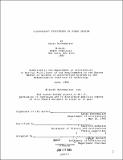Lightweight structures in urban design
Author(s)
Bonnemaison, Sarah
DownloadFull printable version (9.059Mb)
Alternative title
Urban design, Lightweight structures in
Other Contributors
Massachusetts Institute of Technology. Dept. of Architecture.
Advisor
Stanford Anderson.
Terms of use
Metadata
Show full item recordAbstract
Lightweight architecture questions how we architects think about the environment. It has qualities which complement "mainstream" buildings. This thesis will explore these qualities and will propose that this architecture is rooted in the modern sensibility and suggests an attitude towards the environment that is needed in our cities. Lightweight architecture is concerned with optimal and, particularly, parsimonious use of materials and effort. Much lightweight architecture is tensile as structures loaded in tension use the least amount of material. Now that modern technology and materials have opened up possibilities· in research and application, much of the research has been done and is no longer the exclusive realm of trained engineers. The question of application of this technology remains -- this is up to the architects. The style of lightweight architecture can be looked at in terms of aesthetic, the process by which one develops its forms and the way of thinking from which it arises. The aesthetic of lightweight architecture enriches the traditional aesthetic notion familiar to us (symmetry, proportion and balance) with the more elusive notions of dynamic symmetry, relative harmony and equilibrium. Form-finding is an experimental process of trial and error. It stems not only from the scientific discipline of static, but from other disciplines , explored from without. In this way, unexpected combinations appear. Complementing static research into the minimal use of materials, vernacular constructions and biology have been used for a greater understanding of parsimony in building. The "logic of reasoning" refers to a creator's conception of the world in which one creates. The designers of lightweight architecture believe in a world not of specialization and analysis, but of creation and adaption, an ecological view of the world. Because the process of creation is more important that the resultant form, the syntactics of structural and formal assembly takes precedence on an analogical basis for form-finding.The second section of this thesis explores lightweight architecture in the city. The current trend of placing lightweight buildings in parks rejects the possibilities of lightweight architecture can offer the city. Many architects see a conflict in the juxtaposition of lightweight buildings against traditional load-bearing urban "fabric". Lightweight architecture implies notions of boundary and mutability that are contrary to these same notions as represented in industrial cities. Being ephemeral, mobile and adaptable, this architecture, by its unboundedness, forces us to re-assess our notion of boundary. Lightweight architecture, allows for a rapid adaption of buildings in the city to climatic change and for the periodic gathering of festivals and markets. The adaptive, mutable qualities lightweight architecture can bring to the city are particularly valuable for urban public spaces. This architecture allows for human engagement with the environment and with each other. The load-bearing wall and its function in the city -- the separation of one activity from another and the definition of privacy -- has been radically redefined by the advent of the glass curtain wall and the telephone. This process has left us with ambiguous urban "public" spaces not much used by the public yet not truly private. Re-introducing a mobile, lightweight ephemeral architecture into post-industrial cities is a desire to implement certain socio-political ideas about city culture and simultaneously make places where those policies are lived.
Description
Thesis (M.S.)--Massachusetts Institute of Technology, Dept. of Architecture, 1985. MICROFICHE COPY AVAILABLE IN ARCHIVES AND ROTCH. Includes bibliographical references (leaves 83-84).
Date issued
1985Department
Massachusetts Institute of Technology. Department of ArchitecturePublisher
Massachusetts Institute of Technology
Keywords
Architecture.